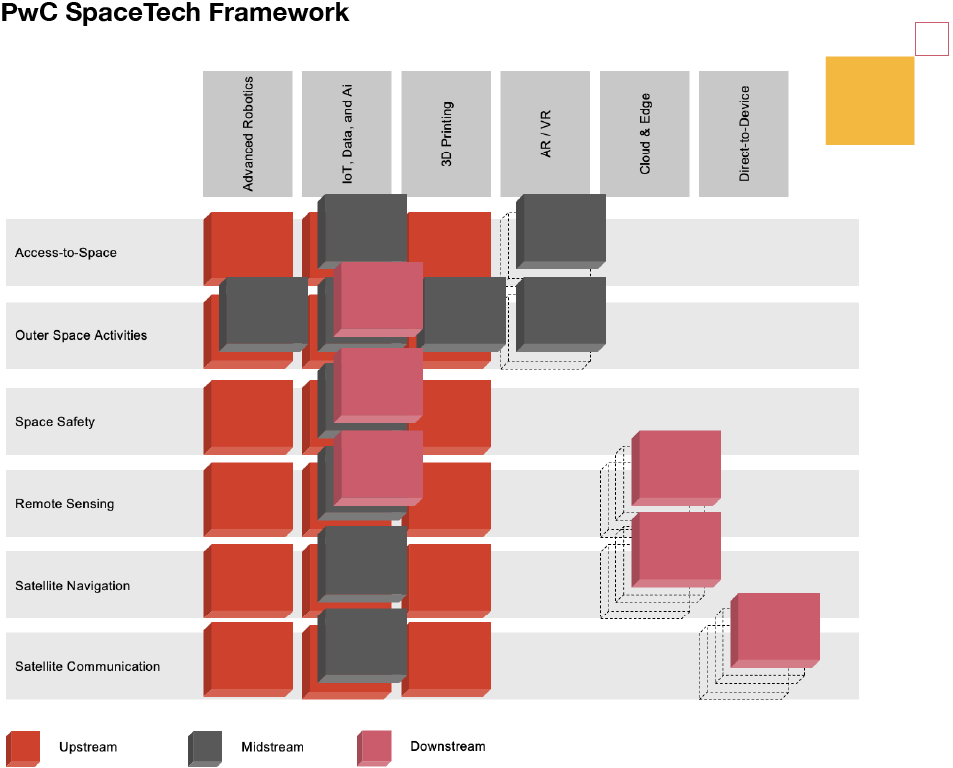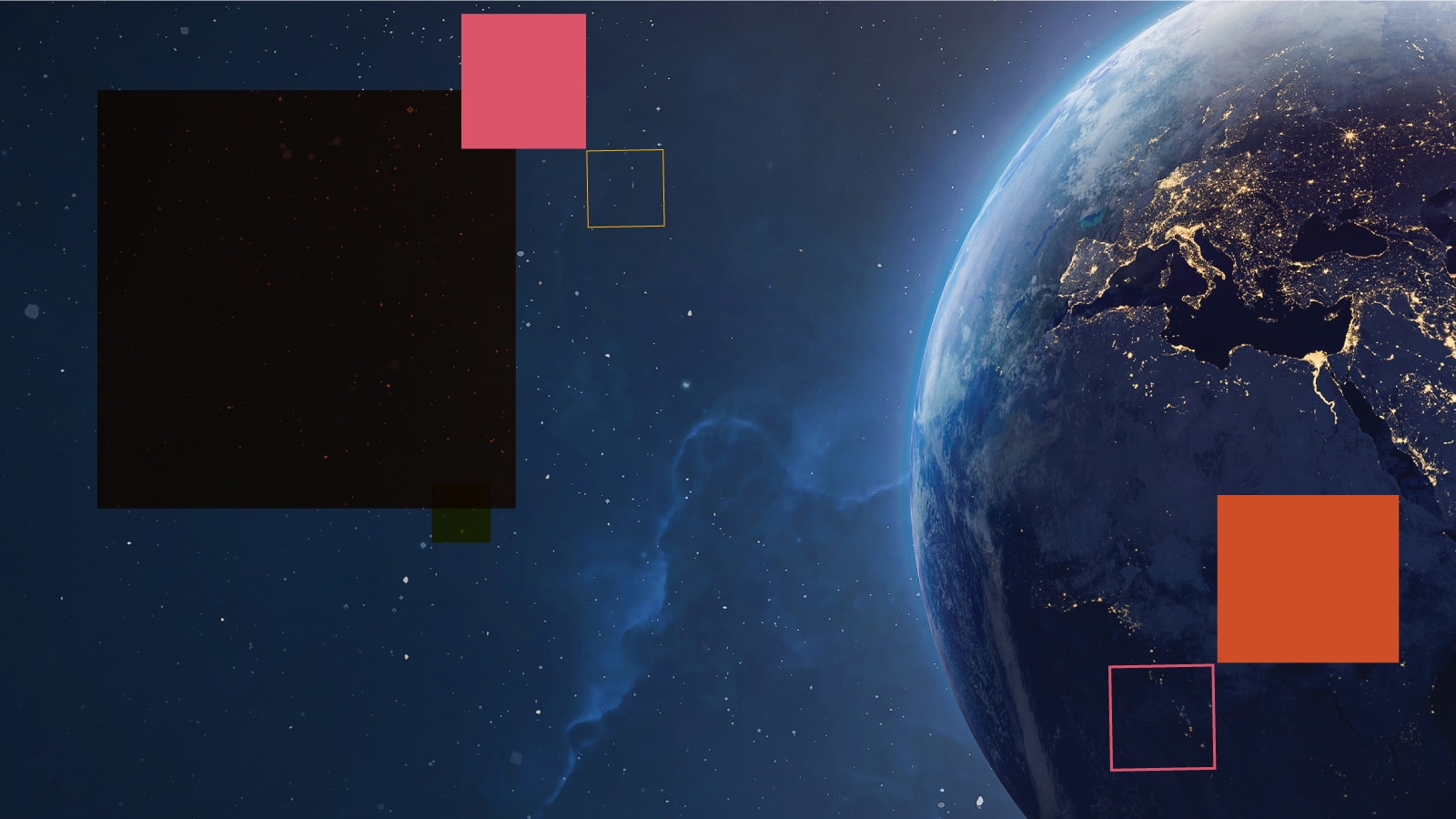There has been much discussion about recent developments in the space sector, the democratisation and consumerisation of space industries, and the decreasing cost of manufacturing. However, it is important to note that space and technologies, particularly those related to digital and communication, should not be considered separately. They have inspired each other since the second half of the 20th century. SpaceTech is already a reality and the potential for innovation and economic growth resulting from the space and technology sectors is enormous.
SpaceTech and Geospatial
The global space sector is experiencing significant growth and transformation, driven by the democratisation and commercialisation of the space industry.
Examples from history
Here’s a timeline of digital technologies used, enhanced or made possible by developments in the space sector.
1960s – Video conferencing: NASA's need for remote communication during space missions led to the development of early video conferencing technology in the 1960s, enabling real-time collaboration across vast distances.
1960s – Wireless headset: NASA were looking for a lightweight and wireless communication system that would allow astronauts to communicate with their teams on earth which would not be damaged or lost on splashdown.
1960s – Digital Signal Processing: Used for processing the Apollo 11 video in real time, later used for audio compression and image/video processing.
1970s – Heart Echo Scans: NASA engineers developed an echo-cardioscope to monitor cardiac functions of astronauts in flight. It forms images of internal structures using high-frequency sound.
1980s – Digital Imaging: The active pixel sensor in most digital image-capturing devices was invented when NASA needed to miniaturise cameras for interplanetary missions. It is also widely used in medical imaging and dental X-ray devices.
1990s – Weather Monitoring Systems: Weather/environment satellites that provide high resolution images of Earth’s atmosphere for use in such applications as cloud top temperature monitoring, hazardous weather prediction and crop monitoring.
2010s – Metal 3D Printers: A high-precision 3D printer capable of manufacturing items in microgravity out of resources mined in space to produce spacecraft components.
2010s – Virtual Reality Platform Helps Pilots Land in the Sky: it allows a pilot to practice landing on a virtual runway in the air By superimposing virtual elements over a view of the real world, it allows for safer, more accurate, and cheaper training.
2010s – Drone/Car Anti-collision Software: Neurala is working to house both processing and memory capabilities in one “brain” rather than relying on cloud computing. This uses less energy, speeds reaction time, and would be essential for a self-learning Mars rover
2020s – Medical-Grade Smartwatch: EmbracePlus is a smartwatch for astronaut monitoring and clinical research.
Advancements of the region
The region has witnessed, over the last few years, ambitious plans for the space and technology sectors. Significant advances have also been made by countries of the Gulf Cooperation Council (GCC), with many having their independent space programmes. National transformation agendas, efforts to localise manufacturing and services and the introduction of effective regulation and deregulation will continue to propel the transformation of the sectors.
Last year, KSA sent Rayyanah Barnawi – the first Arab woman in space – to the ISS. On the ground, the the Kingdom is establishing the foundations for the execution of its space strategy which is expected to be released soon. The former Saudi Space Commission has been transformed into the Saudi Space Agency which is already making global news through the inaugural Space Debris Conference in February 2024, expected to be established as a bi-annual event in the Kingdom.
From launching the Arab world’s first Mission to Mars to signing the Artemis Accords, the UAE has also emerged as a leader in space exploration. Emirati astronauts, Hazzaa Al Mansorri and Sultan Al Neyadi flew on ISS missions in 2019 and 2023 respectively. The uncrewed Mars mission “Hope Probe” was launched in 2020 and is in Mars orbit since 2021.
In the space sector, Oman has published its 10-years “Policy and Executive Programme” (that includes plans to construct the first space port in the Middle East in 2023), promptly followed by hosting the first Middle East Space Conference in 2024 earlier this year.
GCC governments are also already investing heavily in the technology sector. From early adoption of electronic government to the first minister of AI in the UAE, from the vision of NEOM as a cognitive city to strengthening cyber security in KSA, the government agendas in the GCC have been technology-driven for a long time.
PwC SpaceTech Framework
Various advanced and emerging technologies play a key role across space sector activities. In PwC Middle East, we have established a framework mapping these technologies against a taxonomy of business, research and exploration activities in the space sector.
The framework reveals the relationship between Space and Technology, it helps us to identify application areas, clusters of entrepreneurial activities and description, profiling and measurement of economic activities across the Space upstream, midstream, downstream value chain.
Technology is pervasive across the six space sector domains highlighted in the framework: Access to Space, Remote Sensing, Satellite Communications and Satellite Navigation, Space Safety and Outer Space Activities.

Our framework suggests a view of space and technology as essentially one single innovation engine for countries and economies. Policymakers and regulators must work together across sector boundaries to leverage this economic and innovation potential. Only through the juxtaposition of space activities and related digital technologies will we be able to discover all investment and innovation opportunities, clusters of entrepreneurship, skills gaps, and required improvements to legislative and regulatory frameworks, just to name a few opportunities, As the socio-economic transformations across the region continue to be daring, aspirational and powered by strong commitment from regional leaders, the economic spillover from space, tech and indeed, “SpaceTech” will drive the digital economy for a while.
Download our paper here
Case studies
The Microchip:
The Apollo programme stands as a monumental achievement in human history, showcasing the power of science, engineering, and exploration with the historic 1969 Moon landing. Amidst numerous challenges, the success of Apollo hinged on pioneering technologies, notably the Apollo Guidance Computer (AGC), a digital computer that emerged as the unsung hero. The AGC computer was revolutionary since it leveraged integrated circuits or microchips, which allowed NASA engineers to maximize system performance while minimising size and weight to meet the various constraints posed by the mission. This breakthrough not only propelled humanity to the Moon but also accelerated the development and adoption of integrated circuits.
Satellite communication:
In the 1960s, the first commercial communication satellites became operational. In fact, the 1964 Olympic games in Tokyo, was the first mega global event with satellite-transmitted television coverage. SatComms is the use of artificial satellites to provide communication links between various points on earth. Today, the SatComms domain has expanded with governments and businesses growing keen on providing complete communications and internet coverage across the globe, especially in remote areas which do not benefit from fixed signal receptors. Today, more than 6,000 Low Earth Orbit satellites are orbiting earth and providing internet coverage worldwide.
Positioning and navigation:
The US-owned Global Positioning System (GPS) uses satellite positioning and navigation systems and was developed primarily for military and national security purposes. But it was gradually opened up through the 1990s. In mid-2000, the GPS services opened up for civil and commercial use and was made available and free for use worldwide. Since then, we’ve seen an explosion of use-cases and it’s not only our Uber or Zomato; applications span across many sectors including agriculture, mining, logistics (fleet, port, and airports operations) and many more.










